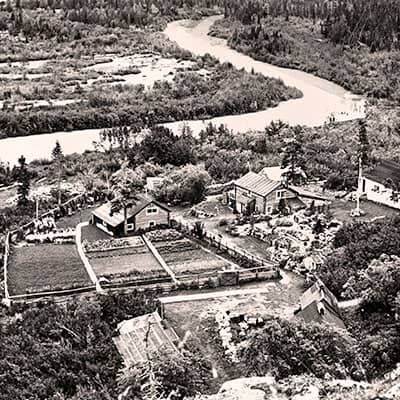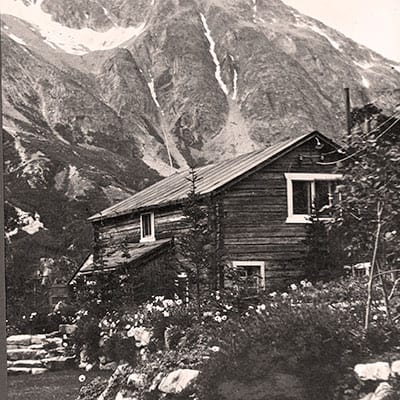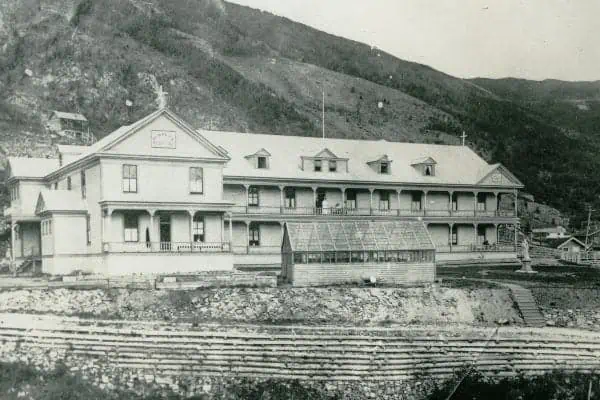Otto and Kate Partridge pictured in their garden at Ben-My-Chree. PHOTO: MacBride Museum Collection, 1989-1-2
“It was then that a little silver-haired lady in velvet and lace came to the door—our lady of the wilderness—and bade us enter.” –Frederick Niven, 1938
It’s a story many times told but never gets old, this tale of Kate and Otto Partridge of Ben-My-Chree, which is Manx for “Girl of my Heart” and is the greatest love story in the history of the Yukon. It’s simply a mad irony that most of it took place in northwestern B.C. at the very southern end of Tagish Lake after it makes a hard western turn and ends in a cul-de-sac against a wall of glacial mountains near the Alaska border.
Fanny Kate Pridham was born in 1854 at Carmarthenshire, Wales. Otto H. Partridge was born on the Isle of Man in the Irish Sea in 1857. They were first cousins and knew each other since childhood, finally marrying in 1880 when she was 26 and he was 23.
Neither ever looked at another. They grew up thinking they would spend their lives together; and so they did until Otto died suddenly on June 28, 1930, the year of their golden 50th wedding anniversary, and Kate followed on January 10, 1931. They are buried side by side in Whitehorse’s Pioneer Cemetery.
By the time of the Klondike Gold Rush in 1897 when Otto was 40 and Kate 43, they had been living in Wales where Otto progressed from a young apprentice to a master shipbuilder in a place world-renowned for the quality of seagoing vessels produced there, and Kate was well known for her green thumb which produced all of their vegetables and flowers including many for sale to supplement the family income.
As soon as they heard the stories about ships loaded with gold arriving in Seattle from a place called “The Klondike,” Otto set off alone in 1897 to climb the Chilkoot and Kate joined him in 1898 after carrying a portable organ over the pass. Their first residence was a homemade houseboat anchored in Milhaven Bay on Lake Bennett where Otto set up his first sawmill.
Even before Kate joined him, Otto found himself with four sources of income:
- Showing the inexperienced stampeders how to build scows and riverboats tough enough to make it to Dawson,
- General manager of a Bennett-based navigation company,
- Building three small lake steamers for his own company, which he named Ora, Dora and Flora and
- As if he wasn’t busy enough, because of his knowledge and experience with wood, the railroad company, BYN (British Yukon Nav.) hired him to cut, construct and deliver all the ties for the railroad under construction that would eventually be called the White Pass & Yukon Route, to which he delivered with his small fleet of fast, sturdy lake steamers.
It was rumoured—never denied—his financing was $20,000 cash hidden in the bottom of an oakum barrel that he smuggled past Soapy Smith in Skagway and Sam Steele at the Canadian border. Talk about the right man at the right place at the right time. As soon as he crested the Chilkoot and walked down to the lakes, his services were required by everybody and the money rolled in.
Neither Otto nor Kate ever made it past Whitehorse or reached the Klondike. By 1899, the stampeders were all gone; in 1900 the railroad got past the Rapids and ceased at Whitehorse while the Partridges settled down into a comfortable and successful transportation business with their three “children” Ora, Dora and Flora.
They stayed busy for a decade out of Carcross until 1910 when Otto was offered a mining partnership with Stanley McLellan and Ludwig Swanson, two prospectors who had located rich hardrock gold veins a mile above lake level in the high mountains at the south end of West Taku Arm on Tagish Lake, which they called Ben-My-Chree to honour Kate. Otto’s role was to supply the mine site with supplies, including Kate’s fresh vegetables, and wood for cribbing timbers which he delivered with his boats. The mine employed anywhere between 10 and 60 miners depending on the season and type of work.
Unfortunately, it was doomed by fate and destroyed during spring thaw in 1911 when an avalanche covered everything, killing McLellan and his wife who lived onsite in a small house made of rocks. The Partridges were unharmed as they lived down on their homestead in the valley, also called Ben-My-Chree, but that was the end of their mining aspirations.

After the tragedy, they increased the size of their gardens. Kate planted two acres with over 40 kinds of flowers and shrubs that flourished in the glacial till during the long 17-hour days. It was reported that Kate’s delphiniums grew to ten feet and her pansies and poppies were 5” in diameter. Otto also increased the vegetable acreage until aerial photos made Ben-My-Chree look like an improbable farm located in a wilderness valley 106 miles from the nearest civilization, which was Carcross.
By 1912, White Pass ships were detouring to the end of the lake to drop off mail and pick up fresh vegetables on their way to the “Switzerland of the North,” which was Atlin. Word quickly spread about the beauty and aesthetics of the Partridge gardens and Otto signed an agreement with White Pass in 1916, in the depth of WWI, to host tourist excursions, from Carcross, that featured Kate dressed like a lady in the wilderness and Otto in formal attire. Kate also entertained in the drawing room on organ and harmonium, and Otto was a natural-born storyteller who loved to tell tales about the Klondike Gold Rush.
By the time they entered the tourist business full-time, Kate was 62 and Otto 59 and they entertained upwards of 9,000 wealthy tourists every season until 1930, with the most famous names in their guest books being Teddy Roosevelt, Lord and Lady Byng and scores of Roaring Twenties celebrities including writers and movie stars. It was not a poor man’s holiday to go sightseeing in the Yukon.

In 1930, after Kate had been widowed in mid-summer, the prominent writer Frederick Niven immortalized her forever with a cover story in Canadian Home Journal, including the quote above. Niven was totally flabbergasted by this widow in the wilderness, and his article was the first step in turning the Partridge family story into a mythical northern love affair that was plugged every year as the White Pass bought Ben-My-Chree and continued the tours until 1956 when lake and river travel ceased due to road construction during and after WWII.
The “Girl of My Heart” is one of the most well-known and oft-repeated northern tales in Yukon history and is only published here as a reminder to modern Yukoners of how the oldtimers used to age in the North before the onset of Dementia Roadmaps, Grief symposiums, old-age newsletters and “deluxe” care facilities that resembled mental hospitals.
And if you dare doubt the veracity of this epic love story, pray tell us who is in second place on this unique Yukon love list? Klondike Kate?




